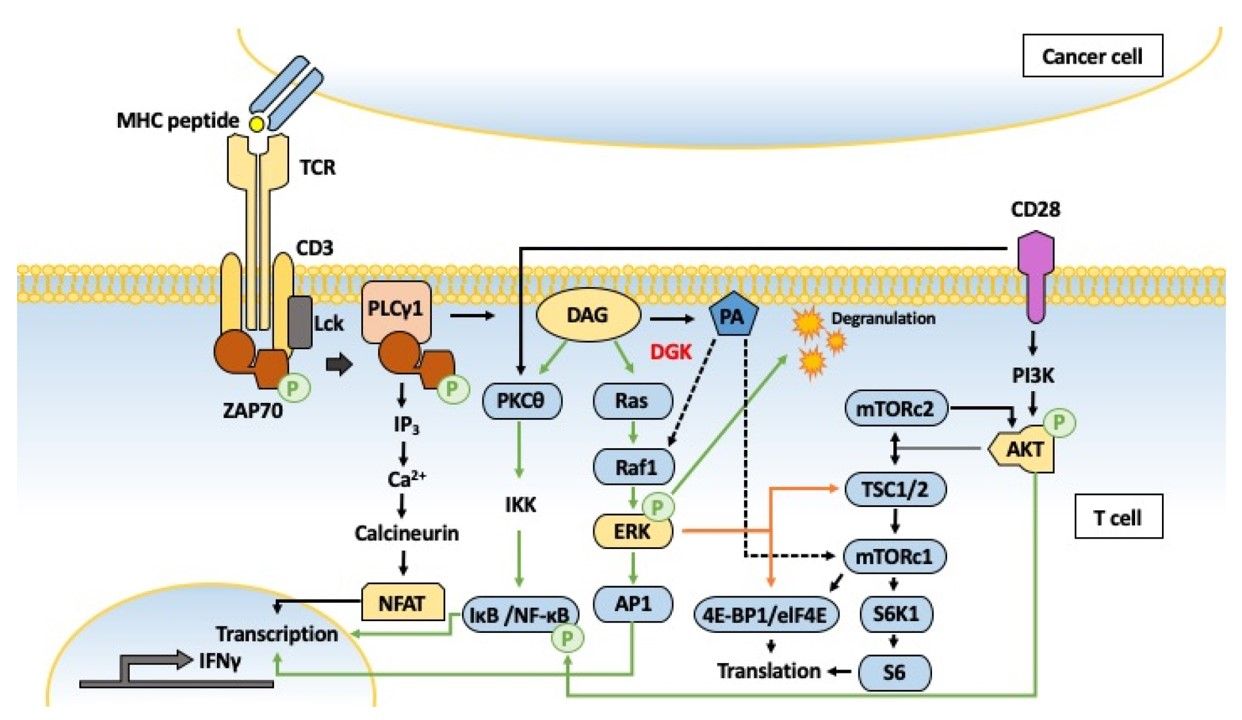Hi-Affi™ DAG activated GPCR Stable Cell Line
GPCRs transduce signals through a variety of cascades and elicit diverse biophysical activities. Therapeutic compounds targeting GPCRs (no matter biologics and small molecules) are designed to interfere with GPCR functionalities via activating (agonist) or blocking (antagonist) certain pathways. Hence, to characterize and understand the agonistic/antagonistic potentials against target GPCR is very critical for GPCR drug discovery. In order to address this demand, Creative Biolabs has launched a full portfolio of GPCR stable cell lines engineered with unique biosensor that can specifically link second messenger activation (i.e. Ca2+, cAMP, DAG) to fluorescent changes, which can effectively facilitate compound screening & characterization.
DAG Signaling Pathway
Multiple G-protein isoforms play vital roles in signal transduction, the Gq is a subtype of G-protein alpha subunits and involved in the activation of the phosphatidylinositol signaling pathway. Gq protein can activate phospholipase C (PLC) that cleaves a phosphatidylinositol 4,5-bisphosphate (PIP2) into diacyl glycerol (DAG) and inositol 1,4,5-trisphosphate (IP3). IP3 is released into the cytosol while DAG still bounds to the membrane. IP3 then diffuses through the cytosol to bind to IP3 receptors, especially calcium channels in the endoplasmic reticulum (ER). These channels are specific to calcium and only allow the passage of calcium to move through. This will subsequently lead to an increase of cytosolic concentration of calcium, resulting in a cascade of cellular biophysical activities. DAG pathway plays an important part in a wide variety of human bodily processes. For example, thrombin receptors in platelets rely on this pathway to promote blood clotting.
 Fig.1 Representative signaling pathways regulated by diacylglycerol kinases (DGKs) in the activated T cells.1, 2
Fig.1 Representative signaling pathways regulated by diacylglycerol kinases (DGKs) in the activated T cells.1, 2
DAG-activated GPCR Cell Lines
Our Hi-Affi™ stable cell lines co-expressing fluorescent biosensors and target GPCRs are specifically developed to test drug compounds that interact with DAG signaling pathway. Cytosol-oriented fluorescence can be observed momentarily in respond to DAG activation. These featured cell lines have been widely used as an innovative and sensitive tool for studying the molecular MOA and kinetics underlying GPCR drug candidates. Currently, we provide a wide range of Hi-Affi™ GPCR stable cell lines engineered with DAG-activated biosensor:
- ADRA1A
- ADRA1B
- CCKAR
- Muscarinic 5
Advantages of DAG-activated GPCR Stable Cell Lines
- Mimic natural signaling.
- Enhanced Sensitivity and Specificity by direct measurement of DAG levels.
- Efficient screening of large compound libraries accelerates drug discovery timelines.
- Rapid data generation.
- Reduced background noise.
- Customized cell line development.
Versatile Applications
Our DAG-activated GPCR cell lines provide a powerful and versatile platform for advancing GPCR research and drug discovery. Their physiological relevance, sensitivity, and compatibility with high-throughput screening make them an invaluable tool for diverse applications, such as:
- Identification of novel agonists, antagonists, and allosteric modulators for GPCR targets.
- Investigation of the molecular mechanisms underlying GPCR activation and signaling.
- Assessment of the potential toxicity of drug candidates on GPCR-mediated cellular processes.
- Characterization of the pharmacological properties of GPCR ligands, including potency, efficacy, and selectivity.
With years of non-stop efforts, scientists in Creative Biolabs are happy to leverage our expertise and resources to help our clients and address diverse custom demands. We offer customized work plans tailored to satisfy each specific requirements from our customers. Please contact us for more information and a detailed quote.
References
- Sim, Jae Ang, Jaehong Kim, and Dongki Yang. "Beyond lipid signaling: pleiotropic effects of diacylglycerol kinases in cellular signaling." International journal of molecular sciences 21.18 (2020): 6861.
- under Open Access License CC BY 4.0, without modification.
For Research Use Only.
